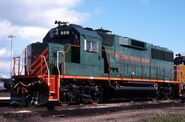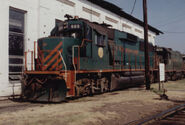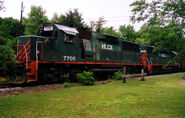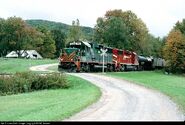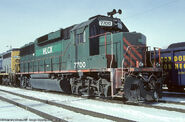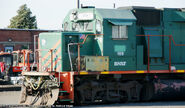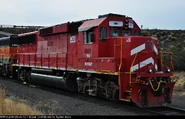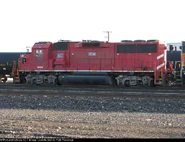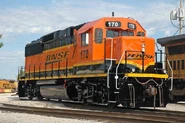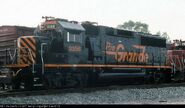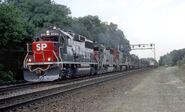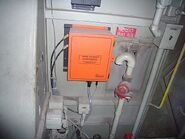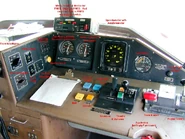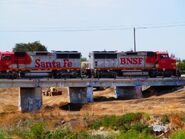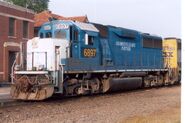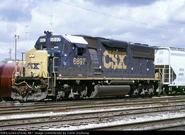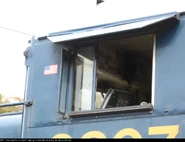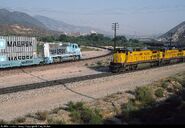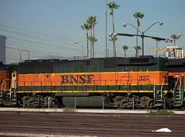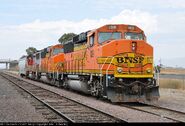The EMD (Electro Motive Division) GP60 is a type of four-axle, 16-cylinder, 3,800HP diesel-electric locomotive built from 1985 to 1994, and marked one of the first 3rd-generation diesel locomotives built for the North American market. Despite its initial success upon debut, the locomotive model was the last completely new type of four-axle diesel locomotive built for the primary market by EMD. However, the recent GP22ECO has since caused debate in recent years (despite being a type of rebuild reminiscent of the BL20-2).
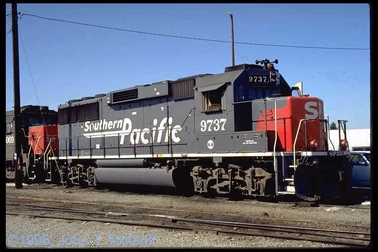
An SP GP60 leading a an SSW GE B40-8: the main rival to the model
294 were built, with an additional 63 wide-cab GP60M and 23 cabless GP60B "B-units" built for the ATSF, making the total of 380 units produced; a rather small number when compared to models such as the GP40, GP38-2, or GP35. The SD60, its six-axle counter-part, completely outsold the model 3:1; despite the GP60 serving as a "last resort" for the four-axle diesel locomotive market.
Southern Pacific (SP; including SSW), Santa Fe (ATSF), Denver And Rio Grande Western (DRGW), Norfolk Southern (NS), the Texas-Mexican Railway (TM), and the US Department of Energy (SROX) were the original customers to purchase the model, while current owners include CSX, BNSF, and Union Pacific (UP). NS and SROX are the only remaining original owners.
CSX acquired three former EMDX demonstrators (EMDX 5-7, now CSX 6897-6899) sometime in 1999-2000 for use in local and/or yard service, while UP currently operates ex-SP, SSW, and DRGW GP60's acquired through the 1996 SP merger for yard and local service as well. BNSF on the other-hand, operates all ex-ATSF GP60 and subsequent GP60M and B-units inherited through the 1996 BNSF merger along with operating two ex-Vermont Railway units (ex-HLCX, nee TM) acquired sometime in 2011 for said same purpose. NS currently utilizes their fleet in general revenue service, but has since re-regulated several units to yard and/or local duties as well rather than for primary use.
All are currently in service as yard switchers or are employed in local service with one unit in particular (BNSF #170), has been rebuilt from an ex-ATSF GP60B using the cab of an ex-UP SD40-2 (UP #3751).
A similar model, the 12-cylinder, 3,000hp GP59 was constructed from 1985 to 1989, and was delivered exclusively to Norfolk Southern (NS).
It was (ironically) the only other 3rd generation diesel built by EMD to outsell its rival: the GE B40-8.
History[]
During the late-1980's into the early 1990's, many major and drastic changes began to occur for EMD. What was once the leading locomotive builder in the United States (along with the rest of the world), had officially lost said status to long-time rival
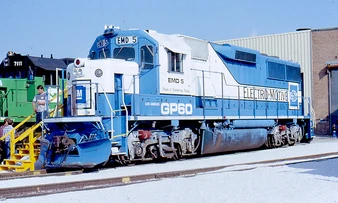
EMD 5 on display at LaGrange, IL.
GE upon the debut of the C40-8 from the famed Dash 8 line. Among the many changes was the relocation of their LaGrange, Illinois locomotive manufacturing facility operations to their Canadian GMD facilty in London, Ontario; meaning that all major manufacturing for domestic models was to commence or continue in Canada rather than in the United States. Thus, beginning sometime in 1988, all domestic (American) models were manufactured at EMD's (GMD's) London facility until 2012 (minus a few exceptions).
The GP60 was ultimately one of the first official domestic diesel locomotive models to debut from the London facility (despite the three demonstrators and numerous other units having been built at LaGrange). But beside said changes, the model was essentially a complete upgrade from the preceding GP50: having more advanced microprocessors which replaced hundreds of wiring circuits, dozens of relays, and all but one module card, making it an improvement among the previous model. Other features included an improved dynamic braking grid and a higher horsepower output as a result of being equipped with an updated version of the D87 traction motors, as well as the new 16-710G3A prime-mover or engine, which was a drastic improvement over the over-stressed 16-645F3B (which was essentially equivalent to the original 16-645F as utilized on the SD50) that was plagued with countless problems and issues from the beginning.
Upon its debut or introduction, the three original demonstrators were tested and evaluated throughout every Class 1 railroad system at the time. Although they were successful, the model only proved to be popular with Western-based carriers such as SP and ATSF. Furthermore, such demonstrations primarily garnered the attention of Southern Pacific (SP) in the first place, whom the railroad ordered a total of 195 units split into three separate orders (SP 9600-9619, SSW 9620-9714, and SP 9715-9794), and were utilized on the railroad's high-speed intermodal service; the GP60's original intended purpose like its predecessor. Like the SP, the ATSF sought interest with the model, and utilized their fleets for the same said purpose alongside their existing GE B40-8 units (and subsequent B39-8 testbeds), but eventually partnered with EMD to develop their own unique variants which were ordered upon request from the railroad. Besides the t
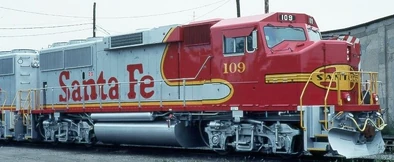
An ATSF GP60M (ordered and built specially for the railroad).
wo latter companies, upon the finalization of the merger between the SP and DRGW in 1988-1989, the railroad received three GP60 units (DRGW 3154-3156); the smallest fleet out of all Class 1 customers, which also were part of the DRGW's last order for any diesel locomotive, for the UP-SP merger in 1996 ended the latter.
Meanwhile, eastern carriers such as Norfolk Southern ordered a small total of 50 units prior to their placement of 33 (later 36) GP59's. SROX on the other-hand, ordered one GP60 (along with a B40-8) to sort and switch out freight cars along the Savannah River Site nuclear reservation. Said units are often rare to spot, for they are typically left in storage or never venture far beyond the facility.
GP60M[]
Following the railroad's order of 40 standard-cab GP60 units, the ATSF placed an order of 63 GP60M's which were fitted with an early version of the now-standardized "American Safety Cab" (or "wide-cab") in 1990. Said units were also painted in the revived "Warbonnet" scheme (which was the first time in which said livery was applied since the 1960's), and were part of the ATSF's "Super Fleet".
Often at times, the GP60M was often regarded as being one of the most uncomfortable diesels for any crew to ride in on the ATSF, for many employees or crew members often complained over how badly the cab rattled, shook, and rode too low to the ground resulting in an otherwise uncomfortable ride. Hence, the road's subsequent B40-8W units were often generally favored.
GP60B[]
The first of their kind since the 40 GP30B units delivered to UP in 1963 (excluding first-generation diesels), the GP60B was built upon request from the ATSF in 1990 in an effort to boost the speeds of their otherwise "hot" intermodal express trains between Chicago and Los Angeles. Painted and numbered in the same series as their GP60M cab unit companions, these units served as "boosters" to assist said trains. Despite having only 23 built, they served their short-lived purpose until the BNSF merger in 1996.
The remaining 22 GP60B units now currently reside as spare units or for heavy duty yard and/or local service throughout BNSF's system (notably in Southern California).
Specifications[]
| Model | GP60 | GP60M | GP60B |
|---|---|---|---|
| Production Dates | 1985-1994 | 1990 | 1990 |
| Total Built | 294 | 63 | 23 |
| Length | 59' 9" | 59' 9" | 59' 9" |
| Axle Arrangement | B-B | B-B | B-B |
| Engine | 16-710G3A | 16-710G3A | 16-710G3A |
| Horsepower Rating | 3,800 | 3,800 | 3,800 |
| Alternator | AR17 | AR17 | AR17 |
| Traction Motors | D87B | D87B/D87BTR | D87B/D87BTR |
| Weight | 273,000 | 282,000 | 270,000 |
Production Roster[]
| Company | Quantity | Road Numbers | Notes/Status |
|---|---|---|---|
| ATSF (Atchison, Topeka, And Santa Fe; or Santa Fe) | 40 | 4000-4039 | To BNSF 8700-8730, 8732-8739 (ATSF #4031 wrecked & retired); renumbered to BNSF 159-197 2014. |
| US Department of Energy (SROX) | 1 | 106 | Used at the Savannah River Site near Aiken, South Carolina. |
| Denver And Rio Grande Western (DRGW; Rio Grande) | 3 | 3154-3156 | Now part of Union Pacific (UP) and numbered 1900-1902; last new diesels ordered by the DRGW. |
| EMDX | 3 | 5-7 | GP60 demonstrators. Leased to LLPX, and sold to CSX in 1999-2000. Now CSXT 6897-6899. |
| Norfolk Southern (NS) | 50 |
7100-7150 (#7117 omitted). |
NS #7100 was originally #7117. The unit was involved in a fatal accident in which the conductor was killed, and after being repaired in July 1998 at the request of the victim's family that NS no longer use said number, was renumbered to NS #7100. #7137 was scrapped following another accident. |
| Southern Pacific (SP) | 100 | 9600-9619, 9715-9794 | Now with UP and renumbered 1902-1921 and 2015-2097. SP #9340 scrapped following the San Bernardino train disaster of 1989. |
| St. Louis Southwestern Railway (SSW; Cotton Belt) | 95 | 9620-9714 | Now UP 1984-1987, 1990–1993, 1997–2000, and 2003–2014. |
| Texas Mexican Railway (TM) | 2 | 869-870 | Now part of BNSF. Originally 168 and 169 and renumbered to BNSF 198-199 in 2014. |
Note: Several ex-SP and SSW GP60 units remain unpatched (not containing any UP reporting marks or patchwork) and retain their original respective numbers from their previous owners. Technically, units such as SP #9721 would be referred to as such, rather than avoiding confusion between UP #9721: a C44-9W.
GP60B Production Roster[]
| Company | Quantity | Road Numbers | Notes/Status |
|---|---|---|---|
| ATSF | 23 | 325-347 |
BNSF #170 has been rebuilt to a cab unit using the cab of an ex-UP SD40-2 (UP #3751). |
GP60M Production Roster[]
| Company | Quantity | Road Numbers | Notes/Status |
|---|---|---|---|
| ATSF | 63 | 100-162 | Now BNSF 100-162 (142, 144, 148, 152 wrecked and retired); BNSF 159-162 renumbered to 142, 144, 158, and 152 in 2014. |
Trivia/Facts[]
What was originally unique about the three GP60 (and subsequent GP59) demonstrators was their "Aerodynamic" (or simply "Aero") cabs: their angular and rounded appearance (along with their SP-style light gear) made them virtually distinct among other four-axle "Geeps". The overall distinct style was meant to reduce wind resistance or drag when operating at high speeds. However, the cab design proved to be ineffective, and EMD decided to revert back to the original "Spartan cab" design typically found on all 2nd-generation models.
Ironically, TM #869 became HLCX #7700 on two occasions: prior to its auction to Vermont Railway (VTR), and after its ownership from the shortline before becoming BNSF 168, and eventually BNSF 198. Remarkably, the unit still retains its VTR livery but with BNSF patchwork rather than HLCX.
TM #870 remarkably retained its original scheme upon entering lease service with Helm Financial (HLCX), along with receiving ownership under Vermont Railway (VTR #382) and lease to the Arizona And California Railroad (AZRC) before becoming BNSF #169, and finally was renumbered to BNSF #199, where it currently retains the "Heritage 3" (H3) scheme.
SP #9721 is a notable example of a surviving unpatched SP GP60 on the UP's roster; being considered a "true" heritage unit as opposed to a mock heritage unit like UP #1996. The unit has been patched and renumbered #1124 in 2014.
Texas-Mexican GP60 Duo Gallery[]
General Gallery[]

